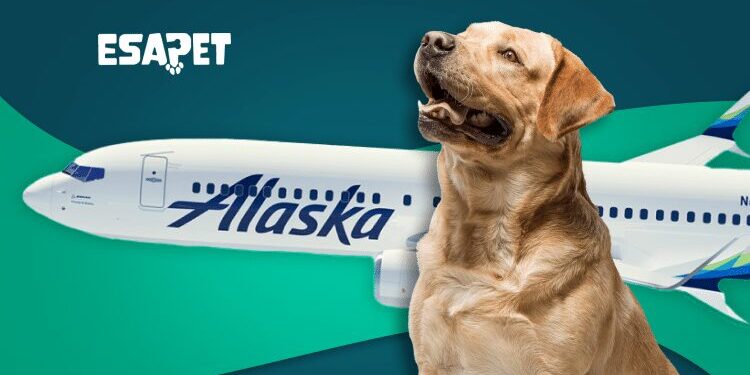Alaska Airlines Pet Policy: Learn How to Fly With Your Pet

Alaska Airlines offers one of the most transparent and pet-friendly travel policies in the U.S. airline industry, emphasizing its “Fur-st Class Care”™ approach. Whether your companion is a small dog, a traveling cat, or a trained service animal, the airline outlines clear, comprehensive procedures that accommodate pets in both the cabin and cargo hold while complying with all federal transportation standards.
This guide details Alaska Airlines’ pet policy as of 2025, covering pet eligibility, fees, carrier requirements, international restrictions, breed-specific limitations, and special considerations for service animals.
Booking a Flight with a Pet: First Steps Matter
Before reserving a spot for your pet, Alaska Airlines requires that passengers first book their own ticket via alaskaair.com. After confirming your reservation, you must contact Alaska Airlines reservations to add your pet to the booking. This step ensures that space is available in either the cabin or the baggage compartment, as both options have capacity limits.
Pet space is limited and subject to availability, especially in the cabin, so early reservations are essential. Additionally, passengers should allocate extra time at the airport for check-in and take their pet to a designated animal relief area before the flight. These facilities are available at many major airports served by Alaska Airlines.
Get your Official ESA Letter Consultation from a licensed therapist.
Get ESA Letter Now
Pets Allowed in the Cabin: Restrictions and Rules
Eligible Animals
As of June 5, 2025, only dogs and cats are permitted to fly in the cabin. Domesticated rabbits and household birds are temporarily allowed through April 4, 2026, but only if tickets were booked before June 5, 2025. For flights to Hawaii and international destinations, only dogs and cats are accepted in the cabin without exception.
Cabin Fees
Passengers will be charged a $100 USD/CAD fee per direction for each pet traveling in the cabin.
Carrier & Size Requirements
Cabin pets must remain fully enclosed within a carrier at all times—including head and tail—and the carrier must fit under the seat in front of the passenger. Approved soft-sided carrier dimensions are 17″ x 11″ x 9.5″. The carrier counts toward the passenger’s carry-on allowance.
Two pets of the same species and similar size may travel in a single carrier, provided they are comfortable and show no signs of distress.
Passenger Requirements
Passengers bringing pets in the cabin must:
- Be at least 18 years old
- Not sit in exit or bulkhead rows
- Ensure their pets remain in the carrier throughout boarding and flight
- Understand that disruptive or odorous pets may be moved to the baggage compartment
Health Certificates
Alaska Airlines does not require a health certificate for pets traveling in the cabin. However, it’s the passenger’s responsibility to verify entry requirements (vaccination and health documentation) with the destination’s state veterinarian office.
Checked Pets: Baggage Compartment (Cargo) Pet Policy
❌ Common Misconception
All pets can travel in the baggage compartment as long as they are in a kennel.
✅ The Reality
Certain pets may be subject to travel restrictions due to safety and health concerns. This includes brachycephalic (short-nosed) breeds, which are more prone to respiratory issues during air travel, as well as pets that exceed airline weight limits.
📌 Alaska Airlines Policy: Specific breed restrictions apply to pets traveling in the baggage compartment.
Additionally, if a pet and its kennel have a combined weight of over 150 pounds, they must be transported using Alaska’s dedicated cargo service, Pet Connect.
Animals Accepted in Cargo
Alaska Airlines allows a wide range of domesticated animals to travel in the baggage or cargo compartment, including:
- Cats, dogs, ferrets, rabbits
- Guinea pigs, hamsters, household birds
- Non-venomous reptiles and tropical fish
- Pot-bellied pigs
For travel to Hawaii or outside the U.S., only cats and dogs are accepted.
Cargo Fees
- $150 USD/CAD per direction
- Discounted to $100 USD/CAD for active-duty military or flights within Alaska
Weight Limitations
The combined weight of the pet and carrier must not exceed 150 lbs. If your pet exceeds this limit, Alaska Air Cargo’s Pet Connect™ service may be used instead.
Kennel Requirements
Pet kennels must:
- Be escape-proof
- Include a metal grated door secured with releasable zip ties
- Comply with USDA and IATA regulations
Plastic doors or flimsy locks are not allowed. Food and water must be offered within four hours of check-in. For layovers exceeding four hours, passengers must be able to access their pet to feed and hydrate.
Breed Restrictions
Short-nosed (brachycephalic) breeds are not permitted in the baggage compartment due to health risks:
- Dogs: Boston Terrier, Boxer, Pug, Bulldog, Shih Tzu, American Pit Bull
- Cats: Persian, Himalayan, Burmese, Exotic Shorthair
However, these animals may still travel in the cabin, provided the carrier meets size requirements.
Weather Embargoes
Alaska Airlines may suspend cargo pet travel during periods of extreme heat or cold, prioritizing animal safety. Passengers should schedule nonstop flights and avoid high-heat midday departures in summer or frigid early-morning flights in winter.
Required Documentation
Pets traveling in cargo must have a health certificate:
- Dated within 10 days of departure
- Valid for 30 days on return travel
Get your Official PSD Letter Consultation from a licensed therapist.
Get PSD Letter Now
International and Hawaii Pet Travel Rules
General International Rules
Only dogs and cats are accepted for international and Hawaii flights. Passengers are responsible for meeting all import/export regulations, including:
- Rabies vaccination certificates
- Quarantine documentation (especially for Hawaii)
- Country-specific requirements (e.g., screwworm tests for Mexico)
Failure to meet these standards may result in denial of entry, quarantine, or return of the animal at the owner’s expense.
Country-Specific Notes
- Canada: Cats must have a rabies certificate issued within the last three years
- Guatemala: Pets not accepted for travel
- Mexico: Dogs must be screwworm-free; only two pets per family per flight allowed into the U.S.
- Hawaii: Due to its rabies-free status, pets arriving without required documentation may be quarantined for up to 120 days
Checked Pet Limitations to Hawaii
Flights to and from Hawaii are restricted due to strong headwinds:
- No dogs or cats accepted as checked baggage in February
- Limited to one dog or cat per aircraft between Nov 1–Jan 31 and Mar 1–Apr 1
- These restrictions do not apply to in-cabin pets
Service Animals: Differentiating from Emotional Support Animals
Emotional Support Animals (ESAs)
Following the 2021 DOT Final Rule, Alaska Airlines no longer classifies ESAs as service animals. ESAs must now travel as pets and are subject to standard pet fees and carrier rules.
Definition of a Service Animal
A service animal is:
- A dog, regardless of breed
- Individually trained to perform tasks related to a disability
This includes psychiatric service dogs (PSDs). ESAs that only provide comfort or emotional support do not qualify as service animals.
Travel Fees
Service animals travel free of charge.
Get your Official ESA Letter Consultation from a licensed therapist.
Get ESA Letter Now
Service Animal Requirements and Documentation
DOT Forms
Passengers may be required to submit:
- Service Animal Air Transportation Form (attests to health, behavior, vaccination, and task training)
- Relief Attestation Form (required for flights over 8 hours, stating how the animal will relieve itself)
Forms may be submitted 48 hours prior or at the gate if booked last minute. Airlines are required to provide access to forms online, at airports, or by mail.
Control and Conduct Standards
Service animals must be:
- Harnessed, leashed, or tethered at all times
- Well-behaved (no barking, jumping, biting, or urinating indoors)
Animals that fail to meet these behavioral standards may be:
- Reclassified as pets (subject to fees)
- Denied transport
Breed and Quantity
- Alaska Airlines cannot deny a service animal based on breed
- Each passenger is limited to two service animals
- Each service animal requires separate DOT documentation
Seating and Space
Service animals can sit:
- On the passenger’s lap
- In foot space, as long as FAA safety rules are not violated
If a dog is too large, passengers may:
- Be reseated
- Use cargo at no charge
- Purchase an extra seat for space accommodation
Liability and Damage
Passengers are financially responsible for any damage caused by their service animal, similar to other passengers.
Get your Official PSD Letter Consultation from a licensed therapist.
Get PSD Letter Now
Conclusion: Flying with Pets on Alaska Airlines in 2025
Alaska Airlines sets the bar for pet travel with safety-first policies, reasonable fees, and clear distinctions between pet types. Whether you’re traveling with a household pet or a trained service dog, knowing the airline’s up-to-date pet policy ensures smooth boarding and stress-free travel.
To recap:
| Travel Type | Accepted Animals | Fee (Each Way) | Health Certificate |
|---|---|---|---|
| Cabin Pet | Dogs, Cats | $100 | Not Required |
| Baggage/Cargo Pet | Most domesticated | $150 ($100 AK) | Required |
| ESA | Reclassified as pets | $100 | Depends on destination |
| Service Animal | Dogs only | Free | DOT Form Required |
Plan ahead, confirm all requirements based on your destination, and consult with Alaska Airlines if traveling with pets internationally. With preparation and compliance, your pet’s journey will be just as comfortable and safe as your own.

Emotional Support Animal, Dogs, Housing
Types of Depression, Risk Factors &...
Jonalyn Dionio
Nov 14 2025

Dogs, Emotional Support Animal, Food, Travel
How to Catch a Fake Service Dog: Tips an...
Jonalyn Dionio
Dec 12 2025





